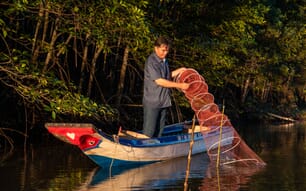“It is a major breakthrough in the history of aquaculture in the country. It has taken almost 10 years to achieve it. This fish is the best candidate for sustainable farming and it cohabits with shrimps and mullets,” said. K.K. Vijayan, director of the CIBA.
A team led by principal scientist M. Kailasam achieved the breakthrough by implanting hormones in the fish, reported TheHindu.
“Instead of injecting hormones, we have implanted hormones and it would be released in a sustainable manner,” Mr Vijayan explained.
Mr Kailasam said broodstocks at the CIBA were eight years old and a matured fish weighing one kilogram would lay one million eggs.
“While it is difficult to breed the fish in captivity, it will continue to breed after the first instance. The survival of juveniles is also good as they do not indulge in cannibalism like Sea Bass,” he said.
Though the fish lives in backwaters, it migrates to the sea for breeding, as suitable saline conditions are vital for the process. Normally, the seeds of milkfish are collected from wild and in the last year alone Andhra Pradesh produced 1,000 tonnes of milkfish. But in the wild it would be available only three months in a year.
The advantage with milkfish is that being a vegetarian (herbivore) it requires only low protein feed and it substantially reduces the production cost. But the one thorny issue is that the fish has a lot of bones.
Countries like Taiwan and Indonesia, known for mass production of milkfish, developed a special mechanism for removing the bones.
“It is like the Hilsa, popular in Bengal. As Tamil Nadu is witnessing migration of workers from the North-East and Hilsa-eating States, milkfish farming is commercially viable,” Mr Vijayan said.
M. Sakthivel, president of the Aquaculture Foundation of India, said milkfish was an answer to malnutrition in the country.
“The government should come forward to rear the fish in all ponds and tanks in every panchayat in the country. It can fulfil the need for protein requirement at a very cheap rate,” he said.
Former Principal Scientist of CIBA, A.R. Thirunavukkarasu said as milkfish could be used as a bait for tuna lining, it could earn foreign exchange through exports.





